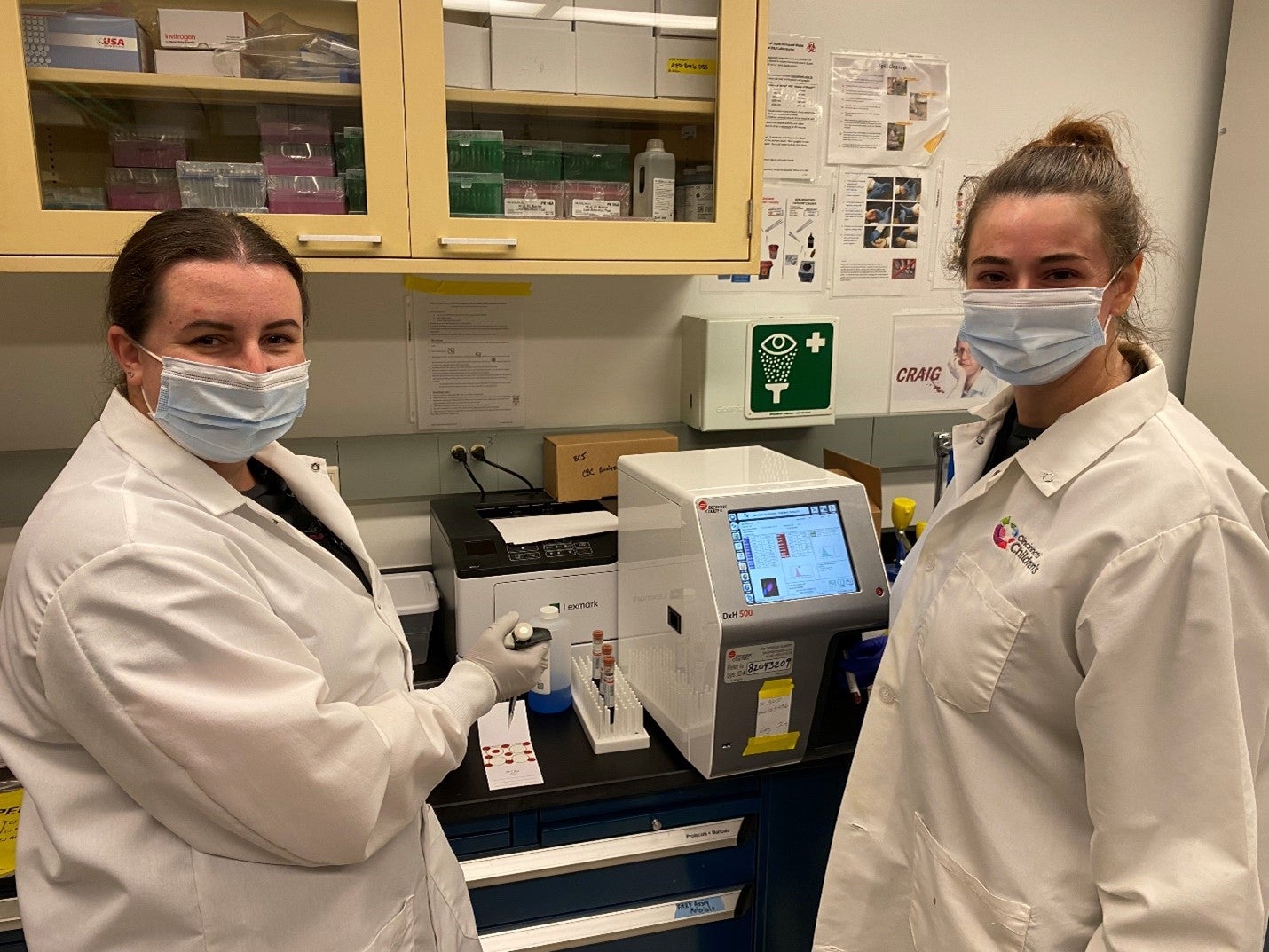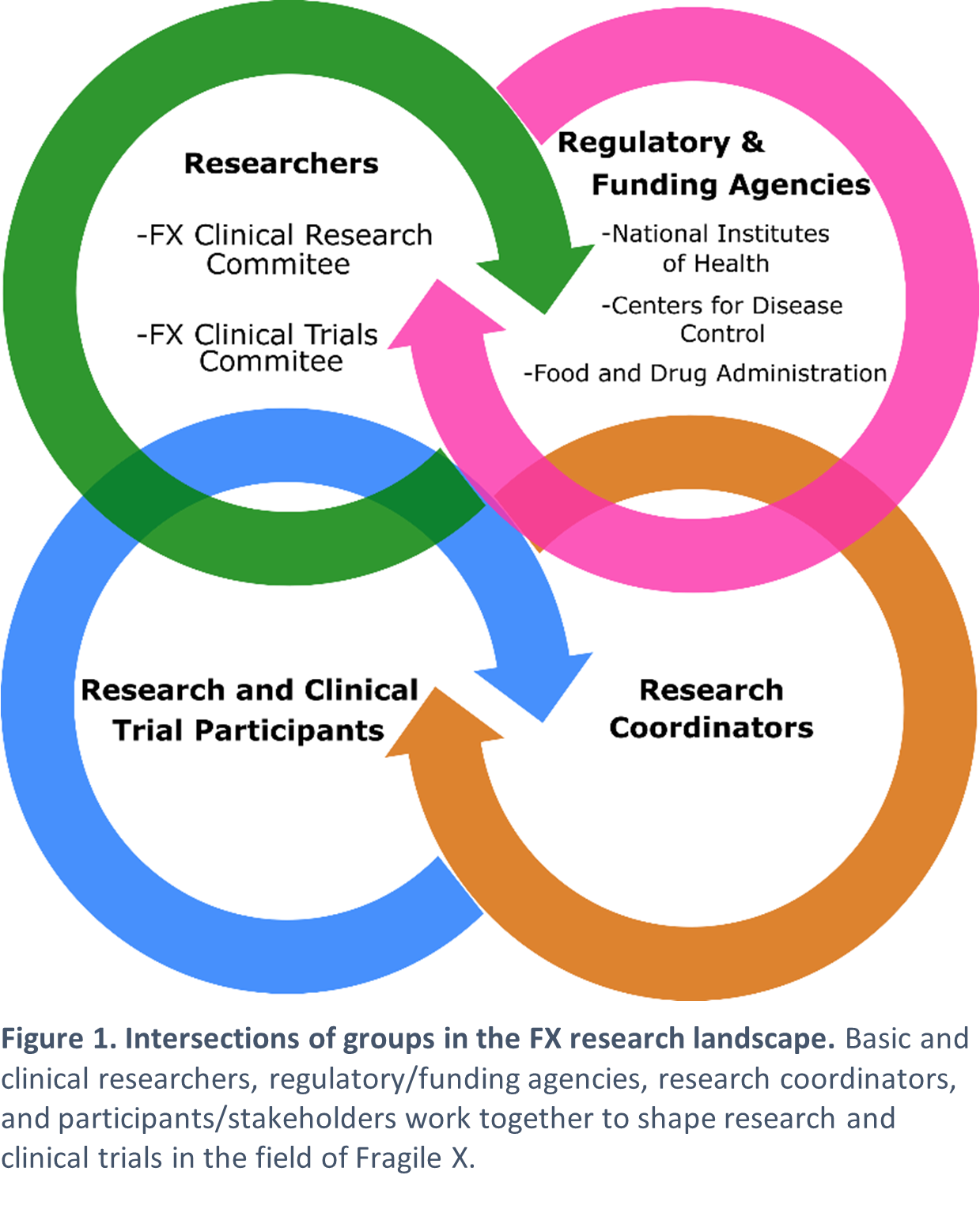Session Presenters: Jun Yi Wang, PhD, Susan Rivera, PhD, Peter Todd, MD, PhD, and Samantha Grudzien
This Basic Research session at the 18th International Fragile X Conference highlighted the latest findings about the FMR1 premutation.
Summarized by: Dr. Carolyn Yrigollen, a 2022 Jr. Investigator

The Effect of Hypertension, Diabetes, and Ventricle Enlargement on White Matter Hyperintensities and FXTAS Progression in Males with Fragile X Premutation
This session kicked off with Jun Yi Wang, PhD, from the UC Davis MIND Institute sharing data from a longitudinal study involving male participants.
Study participants, all with a premutation allele, provided researchers with their historical medical information and had MRI scans of their brains at multiple time points. Researchers diagnosed participants with Fragile X-associated tremor/ataxia syndrome (FXTAS) using radiological criteria such as the presence of the white matter hyperintensity signature at the middle cerebellar peduncle (MCP) and corpus callosum.
To test if type 2 diabetes or hypertension were risk factors for developing FXTAS, researchers asked the participants to self-report any medical diagnosis of these conditions and found that individuals with either of these comorbidities, individuals did indeed have a higher risk of being diagnosed with FXTAS at the end of the study. Enlarged ventricles have previously been associated with cerebral small vessel disease, a condition that can lead to dementia.
Jun Yi reported that both age and hypertension, but not diabetes, were risk factors for small vessel disease in this cohort. Finally, she discovered that larger ventricle volumes measured in the baseline brain MRI resulted in a greater likelihood of white matter hyperintensity.
Why This Matters
Three risk factors were found to increase the risk of developing FXTAS: hypertension, type 2 diabetes, and enlarged ventricles. Not only can this information help researchers understand the underlying mechanisms that lead to a clinical presentation of FXTAS, but diagnostic tests and treatments are readily available for both hypertension and type 2 diabetes. While it hasn’t been tested yet, treating these health conditions might lower the risk of developing FXTAS for individuals with a premutation allele.
Differences in Regional Gray Matter Volume in Fragile-X Premutation Carriers Who Convert to FXTAS: A Longitudinal Voxel-Based Morphometry Study
Susan Rivera, PhD, also presented data collected as part of the longitudinal study at the UC Davis MIND Institute.
This study was comprised of 20 participants with a categorically normal CGG repeat allele (no Fragile X) and 46 who were carriers of an FMR1 premutation allele (had the Fragile X premutation). No participants met the criteria for FXTAS at the study onset.
Over three years the participants were followed with additional brain scans and medical information collected. During the study, 25 carriers were diagnosed with FXTAS and 21 were not. A comparison in gray matter volume between initial and subsequent scans showed gray matter tissue in the caudate and in the right thalamus decreased significantly more in the group of participants with a premutation allele compared to those with normal-sized alleles and decreased even more in the group that converted to a FXTAS diagnosis. Additional loss of volume was observed in basal ganglia and subcortical structures.
Why This Matters
The loss of gray matter volume is shown here to be a useful predictor of individuals with the Fragile X premutation who will develop FXTAS within the next few years. Identifying the regions of the brain that show this degeneration of gray matter will facilitate future research to uncover what is occurring biochemically in the brains of individuals who don’t convert to an FXTAS diagnosis that is neuroprotective. Better predictive models will be important in deciding how to treat a possible future FXTAS diagnosis and give individuals critical information to make lifestyle decisions.
Starting With the End in Mind: Translational Frameshifting and Ribosomal Quality Control in CGG Repeat Associated Neurotoxicity
This session also had two talks interrogating RNA toxicity and RAN translation mechanisms triggered by the Fragile X premutation allele. The first was by Peter Todd, MD, PhD, who shared his group’s findings from the University of Michigan on the unique way that FMR1 is translated when long tracts of CGG repeats are present.
Translation of FMRP is normally initiated at the start codon, approximately 70 base pairs after the trinucleotide repeat. Longer CGG repeats that are categorized as Fragile X premutation length (55-200 repeats) are shown to sometimes initiate before the CGG, or within the CGG sequence. This repeat-associated non-AUG (RAN) translation can synthesize proteins that are long chains of glycine, alanine, or arginine depending on which reading frame is used.
However, when Dr. Todd’s research group assessed the proteins produced from each initiated reading frame, they discovered when RAN translation starts in a polyarginine frame (+0) it becomes stalled, shifts reading frames by one (+1), and continues translating polyglycine peptides. The result is arginine–glycine chimeric proteins, which were found to be toxic. Following the conference, this work was recently published in Nucleic Acids Research [1].
Why This Matters
RAN translation is one mechanism shown to contribute to cellular toxicity in FMR1-associated and other trinucleotide repeat disorders. This research shows that initiation in the polyarginine reading frame consistently leads to higher levels of polyglycine peptides. However, as polyglycine is shown to be insufficient alone to elicit a complete premutation phenotype and chimeric arginine-poly-glycine peptides show cellular toxicity, more information needs to be known about how they are triggering pathology and whether it is possible to control where RAN translation initiates.
Neurodegenerative Synergy Between RAN Translation and CGG Repeat RNA Toxicity in Rodent Models of FXTAS
The final talk for this session was given by Samantha Grudzien, a graduate researcher in Dr. Todd’s research group. Grudzien discussed using novel cell and mouse models to probe how RNA-mediated toxicity and RAN translation contribute to FXTAS pathology either individually or in combination.
To parse out these differences, cells or neonatal mouse pups are transduced with viral vectors containing the FMR1 5’ untranslated region with 100 CGG repeats and protein tags in each reading frame. With this construct, synthesis of the RAN translation polypeptides (polyglycine, +1; polyalanine, +2; and polyarginine +0) can be measured concurrently. Mice injected with this CGG100 construct demonstrated a loss of motor function when tested at 3 and 6 months of age, formation of intranuclear inclusions, and loss of Purkinje cells; all signs of premutation pathology. These mice showed polyglycine RAN translation peptides, which could also be expressed by changing CGG sequences to GGN. The variation of codon sequences introduced by a non-fixed third codon position eliminates RNA-mediated toxicity associated with stretches of CGG repeats. Mice transduced with GGN100 constructs neonatally showed motor deficits at 3 and 6 months of age, but were less impaired than mice injected with CGG100, suggesting RAN translation and RNA toxicity additively cause pathology. Samantha is modeling RNA toxicity in the absence of RAN translation by incorporating a stop codon ahead of the trinucleotide repeat to prevent near-cognate codons from initiating translation.
Why This Matters
The Fragile X premutation allele is causative of FXTAS, but this disease is incompletely penetrant. Both RNA toxicity and RAN translation activity have been detected in animal models and human samples, but the degree to which they contribute to the likelihood of developing FXTAS, or the severity of pathology are unknown. Both mechanisms are triggered by the long tract of CGG repeats which makes studying each independent of the other challenging.
By creating these new model systems, Grudzien has developed tools that can allow her and other researchers to answer questions about mechanisms to pathology in the presence of only RNA toxicity, only RAN translation, or both.
Next Steps
These latest research findings each demonstrated factors that lead to FXTAS pathology and allows researchers to ask new questions that can have an extraordinary impact on the Fragile X community. Risk factors of FXTAS discovered through brain imaging can now be evaluated to determine whether treating hypertension and diabetes will lower the risk of FXTAS. Similarly, identifying prodromic signals of FXTAS allows researchers to study early pathology and factors mitigating disease severity.
Arginine-poly-glycine peptides are a unique chimeric protein that results from aberrant translation of the premutation allele. The contribution of this protein to cellular toxicity and strategies to ameliorate this toxicity are new avenues of research uncovered by this discovery.
Additionally, the new tools developed to separate RNA toxicity and RAN translation will be used to uncover mechanisms of FXTAS pathology. The progress shared during the conference makes us excited for what complexities of FXTAS and potential treatment options will be revealed in the future!
Thanks to presenters, Jun Yi Wang, Susan Rivera, Peter Todd, and Samantha Grudzien for sharing their research!
References
[1] Wright, S. E., Rodriguez, C. M., Monroe, J., Xing, J., Krans, A., Flores, B. N., Barsur, V., Ivanova, M. I., Koutmou, K. S., Barmada, S. J., & Todd, P. K. (2022). CGG repeats trigger translational frameshifts that generate aggregation-prone chimeric proteins. Nucleic Acids Research, 50(15), 8674–8689. https://doi.org/10.1093/nar/gkac626
about

Hilary Rosselot
Hilary joined the NFXF team in 2019. Prior to joining the NFXF team, she worked at the Cincinnati Fragile X Research and Treatment Center for over five years. She has experience as a clinical research coordinator across many types of clinical trials and served as the clinical research manager for the Cincinnati program. She earned a bachelor’s degree in psychology, a master’s, and is a SOCRA certified clinical research professional (CCRP). She enjoys time with family and friends, a great book, a strong cup of coffee and, of course, a good laugh!
learn more
The NFXF is committed to promoting scientific and treatment research advancements for Fragile X-associated conditions and disorders through our research facilitation programming, which includes our NFXF Junior Investigator awards. This program exists to promote and grow future research and treatment professionals in the Fragile X field by providing the invaluable experience of attending, networking, and presenting at the NFXF International Fragile X Conference.
Our 2024 NFXF Awardees
Our 2024 NFXF awards are in! Learn more about each award and the respective awardees.
Summary of the Fragile X Syndrome Basic Science Research session at the NFXF’s 18th International Fragile X Conference
Dr. Anubhuti Goel summarizes the Fragile X Syndrome Basic Science Research session at the NFXF's 18th International Fragile X Conference.
Summary of the Fragile X Premutation Panel Discussion at the 18th International Fragile X Conference
Dr. Connor Maltby, a 2022 Jr. Investigator, summarizes the Fragile X Premutation panel discussion at the NFXF's 18th International Fragile X Conference.
Summary of the Fragile X Messenger Ribonucleoprotein (FMRP) Series at the 18th NFXF International Conference
Dr. Talia Thompson summarizes the Fragile X Messenger Ribonucleoprotein (FMRP) series from the 18th NFXF International Conference
Summary of the Diagnosis and Treatment of Fragile X-Associated Tremor Ataxia Syndrome Panel Session
Dr. Michelle Tosin, a 2022 NFXF Junior Investigator, summarizes the Diagnosis and Treatment of Fragile X-associated Tremor Ataxia Syndrome session at the 18th International Fragile X Conference.
Summary of the Research Landscape Panel at the 18th International Fragile X Conference
Dr. Kate Shelly, a 2022 Jr. Investigator, summarizes the Research Landscape panel at the NFXF's 18th International Fragile X Conference.







